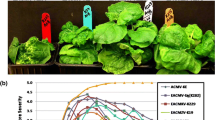Summary
Some cauliflower mosaic virus (CaMV) alleles are selectively lost during growth of the virus in mixedly infected turnip plants. Viral DNA from plants co-inoculated with DNA of the cabbage S isolate and infectious cabbage S DNA with an extra EcoRI restriciion site lacked the extra site. The EcoRI allele was also lost in most plants co-inoculated with a non-infectious mutant of cabbage S DNA while little selective allele loss was observed with two other non-infectious mutant DNAs. Plants co-inoculated with DNAs of closely-related isolates (CM4-184 and W) contained both parental viral DNAs and some DNAs with characteristics of both parents. Interference, scored as a reduced frequency of infection or a delay in symptom appearance relative to plants inoculated with wild-type DNA, occurred when plants were inoculated with wild-type and mutant DNAs covalently attached to one another in partial dimer plasmid DNAs. Similarities in the conditions leading to selective allele loss and those leading to interference suggest that both may have been due to active gene conversion between CaMV DNA molecules.
Similar content being viewed by others
References
Balazs E, Guilley H, Jonard G, Richards K (1982) Nucleotide sequence of DNA from an altered-virulence isolate D/H of the cauliflower mosaic virus. Gene 19:239–249
Benz WC, Berger H (1973) Selective allele loss in mixed infections with T4 bacteriophage. Genetics 73:1–10
Choe IS, Melcher U, Richards K, Lebeurier G, Essenberg RC (1985) Recombination between mutant cauliflower mosaic virus DNAs. Plant Mol Biol 5:281–289
Daubert S, Shepherd RJ, Gardner RC (1983) Insertional mutagenesis of the cauliflower mosaic virus genome. Gene 25:201–208
Fink GR, Styles CA (1974) Gene conversion of deletions in the HIS4 region of yeast. Genetics 77:231–244
Franck A, Guilley H, Jonard G, Richards K, Hirth L (1980) Nucleotide sequence of cauliflower mosaic virus DNA. Cell 21:285–294
Gardner RC, Shepherd RJ (1980) A procedure for rapid isolation and analysis of cauliflower mosaic virus DNA. Virology 106:159–161
Gardner CO Jr, Melcher U, Shockey MW, Essenberg RC (1980) Restriction enzyme cleavage maps of the DNA of two cauliflower mosaic virus isolates. Virology 103:250–254
Gardner RC, Howarth AJ, Hahn P, Brown-Luedi M, Shepherd RJ, Messing J (1981) The complete nucleotide sequence of an infectious clone of cauliflower mosaic virus by M13mp7 shotgun sequencing. Nucleic Acids Res 9:2871–2888
Goelet P, Lomonossoff GP, Butler PJG, Akam ME, Gait MJ, Karn J (1982) Nucleotide sequence of tobacco mosaic virus RNA. Proc Natl Acad Sci USA 79:5818–5822
Howarth AJ, Gardner RC, Messing J, Shepherd RJ (1981) Nucleotide sequence of naturally occurring deletion mutants of cauliflower mosaic virus. Virology 112:678–685
Howell SH, Walker LL, Dudley RK (1980) Cloned cauliflower mosaic virus DNA infects turnips (Brassica rapa, L.). Science 208:1265–1267
Howell SH, Walker LL, Walden RM (1981) Rescue of in vitro generated mutants of cloned cauliflower mosaic virus genomes in infected plants. Nature 293:483–486
Lebeurier G, Hirth L, Hohn B, Hohn T (1982) In vivo recombination of cauliflower mosaic virus DNA. Proc Natl Acad Sci USA 79:2932–2936
Leblon G (1972) Mechanisms of gene conversion in Ascobolus immersus I. Existence of a correlation between the origin of mutants induced by different mutagens and their conversion spectrum. Mol Gen Genet 115:36–48
Maxam AM, Gilbert W (1980) Sequencing end-labeled DNA with base-specific chemical cleavages. Methods Enzymol 65:499–560
Melcher U, Gardner CO Jr, Essenberg rC (1981) Clones of cauliflower mosaic virus identified by molecular hybridization in turnip leaves. Plant Mol Biol 1:63–74
Tomlinson JA, Shepherd RJ (1978) Studies on mutagenesis and cross protection of cauliflower mosaic virus. Ann Appl Biol 90:223–231
Walden RM, Howell SH (1982) Intragenomic recombination events among pairs of defective cauliflower mosaic virus genomes. J Mol Appl Genet 1:447–456
Walden RM, Howell SH (1983) Uncut recombinant plasmids bearing nested cauliflower mosaic virus genomes infect plants by intragenomic recombination. Plant Mol Biol 2:27–31
Author information
Authors and Affiliations
Additional information
Communicated by G.R. Fink
Rights and permissions
About this article
Cite this article
Melcher, U., Choe, I.S., Lebeurier, G. et al. Selective allele loss and interference between cauliflower mosaic virus DNAs. Molec Gen Genet 203, 230–236 (1986). https://doi.org/10.1007/BF00333959
Received:
Issue Date:
DOI: https://doi.org/10.1007/BF00333959




